Dynamic Compression of a SiC Foam
Abstract
1. Introduction
2. Constitutive Model and Formulation
3. Material Properties and Numerical Model
4. Numerical Results
- (1)
- damage growth;
- (2)
- damage stabilization;
- (3)
- fast damage growth.
5. Conclusions
- When the specimen undergoes fast compression, contact between the branches appears;
- In the slow compression case, damage appears in the entire specimen, but the shape of the structure is not changing significantly, which means the specimen undergoes failure due to microcracks;
- In the fast compression conditions, the specimen is fragmented, and the displacements become large and out of the plane; The final shape resembles buckled structure;
- In the observed time interval, the strongly damaged volume (d > 0.95) stabilizes in time for low and medium piston velocities, but for high piston velocity, the damaged volume starts to grow fast at the end of the interval. It corresponds to fragmentation phenomenon in this case;
- Failure of the thin rods in the open cells happens in almost the entire structure of the foam;
- Failure of the thin rods is the main reason for the change in the foam configuration and the foam fragmentation due to loss of continuity between the fragments of the structure.
Author Contributions
Funding
Data Availability Statement
Conflicts of Interest
References
- Rangappa, S.M.; Satishkumar, T.P.; Cuadrado, M.M.M.; Siengchin, S.; Barile, C. (Eds.) Fracture Failure Analysis of Fiber Reinforced Polymer Matrix Composites; Springer: Heidelberg, Germany, 2021. [Google Scholar] [CrossRef]
- Kablov, E.N.; Startsev, V.O. The influence of internal stresses on the aging of polymer composite materials: A review. Mech. Comp. Mater. 2021, 57, 565–576. [Google Scholar] [CrossRef]
- Linul, E.; Serban, D.A.; Voiconi, T.; Marsavina, L.; Sadowski, T. Energy—Absorption and efficiency diagrams of rigid PUR foams. Key Eng. Mater. 2014, 601, 246–249. [Google Scholar] [CrossRef]
- Arora, G.; Pathak, H. Nanoindentation characterization of polymer nanocomposites for elastic and viscoelastic properties: Experimental and mathematical approach. Comp. Part C 2021, 4, 100103. [Google Scholar] [CrossRef]
- Kashfi, M.; Tehrani, M. Effects of void content on flexural properties of additively manufactured polymer composites. Comp. Part C 2021, 6, 100173. [Google Scholar] [CrossRef]
- Golewski, P.; Nowicki, M.; Sadowski, T.; Pietras, D. Bending degradation of thin-walled box beams made of aluminum omega profile and GFRP panel connected by mechanical fasteners. Compos. Struct. 2021, 282, 115111. [Google Scholar] [CrossRef]
- Guo, G.; Alam, S.; Peel, L.D. Numerical analysis of ballistic impact performance of two ceramic-based armor structures. Comp. Part C 2020, 3–4, 100061. [Google Scholar] [CrossRef]
- Huang, L.J.; Geng, L.; Peng, H.X. Microstructurally inhomogeneous composites: Is a homogeneous reinforcement distribution optimal? Progr. Mat. Sci. 2015, 71, 93–168. [Google Scholar] [CrossRef]
- Min, C.; Yang, X.; Xue, M.; Li, Q.; Wang, W.; Mei, X. Micromachining porous alumina ceramic for high-quality trimming of turbine blade cores via double femtosecond laser scanning. Ceram. Int. 2021, 47, 461–469. [Google Scholar] [CrossRef]
- Sha, J.J.; Wang, S.H.; Dai, J.X.; Zu, Y.F.; Li, W.Q.; Sha, R.Y. Improved microstructure and high-temperature mechanical properties of C/C–SiC composites by the introduction of ZrC nanoparticles. Ceram. Int. 2020, 46, 8082–8091. [Google Scholar] [CrossRef]
- Szutkowska, M.; Podsiadło, M.; Sadowski, T.; Figiel, P.; Boniecki, M.; Polczy, T. A novel approach by spark plasma sintering to the improvement of mechanical properties of titanium carbonitride-reinforced alumina ceramic. Molecules 2021, 26, 1344. [Google Scholar] [CrossRef]
- Azizian-Kalandaragh, Y.; Namini, A.S.; Ahmadi, Z.; Asl, M.S. Reinforcing effects of SiC whiskers and carbon nanoparticles in spark plasma sintered ZrB2 matrix composites. Ceram. Int. 2018, 44, 19932–19938. [Google Scholar] [CrossRef]
- Boniecki, M.; Sadowski, T.; Gołębiewski, P.; Węglarz, H.; Piątkowska, A.; Romaniec, M.; Krzyżak, K.; Łosiewicz, K. Mechanical properties of alumina/zirconia composites. Ceram. Int. 2020, 46, 1033–1039. [Google Scholar] [CrossRef]
- Sadowski, T. Gradual degradation in two-phase ceramic composites under compression. Comput. Mat. Sci. 2012, 64, 209–211. [Google Scholar] [CrossRef]
- Clayton, J.D.; Knap, J. Geometric micromechanical modelling of structure changes, fracture and grain boundary layers in polycrystals. J. Micromech. Mol. Phys. 2018, 3, 1840001. [Google Scholar] [CrossRef]
- May, M.; Rupakula, G.D.; Matura, P. Non-polymer-matrix composite materials for space applications. Comp. Part C 2020, 3–4, 100057. [Google Scholar] [CrossRef]
- Sadowski, T. Modelling of semi-brittle ceramics behavior under compression. Mech. Mater. 1994, 18, 1–16. [Google Scholar] [CrossRef]
- Clayton, J.D.; Guziewski, M.; Ligda, J.P.; Leavy, R.B.; Knap, J. Multi-scale approach for phase field modeling of ultra-hard ceramic composites. Materials 2021, 14, 1408. [Google Scholar] [CrossRef] [PubMed]
- Postek, E.; Sadowski, T. Impact model of the Al2O3/ZrO2 composite by peridynamics. Compos. Struct. 2021, 271, 114071. [Google Scholar] [CrossRef]
- Patel, A.; Sato, E.; Takagi, T.; Shichijo, N. Bending fatigue behaviour in an advanced Sic/SiC ceramic matrix composite component at elevated temperature in air. Comp. Part C 2021, 5, 100127. [Google Scholar] [CrossRef]
- Sadowski, T.; Pankowski, B. Numerical modelling of two-phase ceramic composite response under uniaxial loading. Compos. Struct. 2016, 143, 388–394. [Google Scholar] [CrossRef]
- Sadowski, T.; Golewski, G. A failure analysis of concrete composites incorporating fly ash during torsional loading. Compos. Struct. 2018, 183, 527–535. [Google Scholar] [CrossRef]
- Golewski, G.; Sadowski, T. The fracture toughness K-IIIc of the concrete with F fly ash (FA) additive. Constr. Build. Mater. 2017, 143, 444–454. [Google Scholar] [CrossRef]
- Tjong, S.C. Recent progress in the development and properties of novel metal matrix nanocomposites reinforced with carbon nanotubes and graphene nanosheets. Mater. Sci. Eng. R 2013, 74, 281–350. [Google Scholar] [CrossRef]
- Ravichandran, K.S. Fracture toughness of twophase WC-Co cermets. Acta Metal. Mater. 1994, 42, 143–150. [Google Scholar] [CrossRef]
- Hönle, S.; Schmauder, S. Micromechanical simulation of cracks growth in WC/Co using embedded unit cells. Comput. Mater. Sci. 1998, 13, 56–60. [Google Scholar] [CrossRef]
- Li, W.; Wang, H.; Wang, L.; Hou, C.; Song, X.; Liu, X.; Han, X. In situ of fracture behavior of ultrafine WC-Co cemented carbide. Mat. Res. Lett. 2017, 5, 55–60. [Google Scholar] [CrossRef]
- Sadowski, T.; Hardy, S.; Postek, E. A new model for the time-dependent of polycrystalline ceramic materials with metallic inter-granular layers under tension. Mat. Sci. Eng. A 2006, 424, 230–238. [Google Scholar] [CrossRef]
- Postek, E.; Sadowski, T. Thermomechanical effects during impact testing of WC/Co composite material. Compos. Struct. 2020, 241, 112054. [Google Scholar] [CrossRef]
- Postek, E.; Sadowski, T. Impact model of WC/Co composite. Compos. Struct. 2019, 213, 231–242. [Google Scholar] [CrossRef]
- Saleh, B.; Jiang, J.; Fathi, R.; Al-Hababi, T.; Xu, Q.; Wang, L.; Song, D.; Ma, A. 30 years of functionally graded materials: An overview of manufacturing methods, applications and future challenges. Compos. Part B 2020, 201, 108376. [Google Scholar] [CrossRef]
- Ivanov, V.; Sadowski, T.; Pietras, D. Crack propagation in functionally graded strip under thermal shock. Eur. Phys. J. Spec. Top. 2013, 222, 1587–1595. [Google Scholar] [CrossRef]
- Sadowski, T.; Golewski, P. Multidisciplinary analysis of the operational temperature increase of turbine blades in combustion engines by application of the ceramic thermal barrier coatings (TBC). Comput. Mat. Sci. 2011, 50, 1326–1335. [Google Scholar] [CrossRef]
- Sadowski, T.; Golewski, P. The influence of quantity and distribution of cooling channels of turbine elements on level of stresses in the protective layer TBC and the efficiency of cooling. Comput. Mat. Sci. 2012, 52, 293–297. [Google Scholar] [CrossRef]
- Sadowski, T.; Nakonieczny, K. Thermal shock response of FGM cylindrical plates with various grading patterns. Comput. Mat. Sci. 2008, 43, 171–178. [Google Scholar] [CrossRef]
- Klym, H.; Karbovnyk, I.; Piskunov, S.; Popov, A.I. Positron annihilation lifetime spectroscopy insight on free volume conversion of nanostructured MgAl2O4 ceramics. Nanomaterials 2021, 11, 3373. [Google Scholar] [CrossRef] [PubMed]
- Ning, G.; Zhang, L.; Zhong, W.; Wang, S.; Liu, J.; Zhang, C. Damage and annealing behavior in neutron-irradiated SiC used as a post-irradiation temperature monitor. Nucl. Ints. Methods Phys. Res B 2022, 512, 91–95. [Google Scholar] [CrossRef]
- Gibson, L.J.; Ashby, M.F. Cellular Solids—Structure and Properties; Pergamon Press: Oxford, UK, 1988. [Google Scholar] [CrossRef]
- Li, Q.M.; Mines, R.A.W. Strain measures for rigid crushable foam in uniaxial compression. Strain 2002, 38, 132–140. [Google Scholar] [CrossRef]
- Oullet, S.; Cronin, D.; Worswick, M. Compressive response of polymeric foams under quasi-static, medium and high strain rate conditions. Polym. Test. 2006, 25, 731–743. [Google Scholar] [CrossRef]
- Sadowski, T.; Bęc, J. Effective properties for sandwich plates with aluminium foil honeycomb core and polymer foam filling—Static and dynamic response. Comput. Mat. Sci. 2011, 50, 1269–1275. [Google Scholar] [CrossRef]
- Linul, E.; Serban, D.A.; Marsavina, L.; Sadowski, T. Assessment of collapse diagrams of rigid polyurethane foams under dynamic loading conditions. Archiv. Civil Mech. Eng. 2017, 17, 457–466. [Google Scholar] [CrossRef]
- Rajput, M.S.; Burman, M.; Kőll, J.; Hallstrőm, S. Compression of structural foam materials—Experimental and numerical assessment of tests procedure and specimens size effects. J. Sandw. Struct. Mater. 2019, 21, 260–288. [Google Scholar] [CrossRef]
- Pietras, D.; Linul, E.; Sadowski, T.; Rusinek, A. Out-of-plane crushing response of aluminum honeycombs in-situ filled with graphene-reinforced polyurethane foam. Compos. Struct. 2020, 249, 112548. [Google Scholar] [CrossRef]
- Ashby, M.F.; Evans, A.; Fleck, N.A.; Gibson, L.J.; Hutchinson, J.W.; Wadley, H.N.G. Metal Foams: A Design Guide; Butterworth-Heinemann: Boston, MA, USA; Oxford, UK; Auckland, New Zealand; Johannesburg, South Africa; Melbourne, Australia; New Delhi, India, 2000; ISBN 9780080511467. [Google Scholar] [CrossRef]
- Linul, E.; Marsavina, L.; Kovacik, J.; Sadowski, T. Dynamic and quasi-static compression tests of closed-cell aluminum alloys foams. Proc. Rom. Acad. Ser. A 2017, 18, 361–369, ISSN 1454-9069. [Google Scholar]
- Rajak, D.K.; Mahajan, N.N.; Linul, E. Crashworthines performance and microstructural characteristics of foam filled thin-walled tubes under diverse strain rate. Alloy Comp. 2019, 775, 675–689. [Google Scholar] [CrossRef]
- Linul, E.; Pietras, D.; Sadowski, T.; Marsavina, L.; Rajak, D.K.; Kovacik, J. Crashworthiness performance of lightweight composite metallic foam s at high temperatures. Comps. Part A 2021, 149, 106516. [Google Scholar] [CrossRef]
- Linul, E.; Marsavina, L.; Voiconi, T.; Sadowski, T. Study of factors influencing the mechanical properties of polyurethane foams under dynamic compression. J. Phys. Conf. Ser. 2013, 451, 012002. [Google Scholar] [CrossRef]
- Rivero, G.A.R.; Schultz, B.F.; Ferguson, J.B.; Gupta, N.; Rohatgi, P.K. Compressive properties of Al-A206/Sic and Mg-AZ91/SiC syntactic foams. J. Mater. Res. 2013, 28, 2426–2435. [Google Scholar] [CrossRef]
- Mishra, M.K.; Kumar, S.; Ranjan, A.; Prasad, N.E. Processing, Properties and microstructure of SiC foam derived from epoxy-modified polycarbosilane. Ceram. Inter. 2018, 44, 1859–1867. [Google Scholar] [CrossRef]
- Zhang, B.; Huang, H.; Lu, X.; Xu, X.; Yao, J. Fabrication and properties of SiC porous ceramics using a polyurethane preparation process. Ceram. Int. 2018, 44, 16589–16593. [Google Scholar] [CrossRef]
- Colombo, P.; Hellmann, J.R.; Shelleman, D.L. Mechanical properties of silicon oxycarbide ceramic foams. J. Am. Ceram. Soc. 2001, 84, 2245–2251. [Google Scholar] [CrossRef]
- Fukushima, M.; Colombo, P. Silicon carbide-based foams from direct blowing of polycarbosilane. J. Eur. Ceram. Soc. 2012, 32, 503–510. [Google Scholar] [CrossRef]
- Eom, J.H.; Kim, Y.W.; Raju, S. Processing and properties of macroporous silicon carbide ceramics: A review. J. Asian Ceram. Soc. 2013, 1, 220–242. [Google Scholar] [CrossRef]
- Chen, F.; Yang, Y.; Shen, Q.; Zhang, L. Macro/microstructure dependence of mechanical strength of low temperature sintered silicon carbide ceramic foams. Ceram. Int. 2012, 38, 5223–5229. [Google Scholar] [CrossRef]
- Atinkok, N.; Demir, A.; Ozsert, I.; Findik, F. Compressive behavior of Al2O3-SiC ceramic composite foams fabricated by decomposition of aluminium sulfate aqueous solution. J. Compos. Mater. 2007, 41, 1361–1373. [Google Scholar] [CrossRef]
- Lacroix, M.; Nguyen, P.; Schwiech, D.; Huu, C.P.; Savin-Poncet, S.; Edouard, D. Pressure drop measurements and modelling on SiC foams. Chem. Eng. Sci. 2007, 62, 3259–3267. [Google Scholar] [CrossRef]
- Liu, J.; Rong, Y.; Lu, Y.; Zhao, Y.; Wang, L.; Xi, X.; Yang, J.; Huang, Y. Ultralight and mechanically robust SiC foams with interconnected cellular architecture. Ceram. Int. 2020, 46, 17962–17968. [Google Scholar] [CrossRef]
- Sun, X.; Zeng, T.; Zhou, Y.; Zhang, K.; Xu, G.; Wang, X.; Cheng, S. 3D printing of porous SiC ceramics added with SiO2 hollow microspheres. Ceram. Int. 2020, 46, 22797–22804. [Google Scholar] [CrossRef]
- Fan, J.Y.; Wu, X.L.; Chu, P.K. Low-dimensional SiC nanostructures: Fabrication, luminescence, and electrical properties. Prog. Mat. Sci. 2006, 51, 983–1031. [Google Scholar] [CrossRef]
- Huczko, A.; Dąbrowska, A.; Savchyn, V.; Popov, A.I.; Karbovnyk, I. Silicon carbide nanowires: Synthesis and cathodoluminescence. Phys. Status Solidi 2009, 11–12, 2806–2808. [Google Scholar] [CrossRef]
- Xu, S.C.; Zhang, N.L.; Yang, J.E.; Wang, B.; Kim, C.Y. Silicon carbide-based foams derived from foamed SiC-filled phenolic resin by reactive infiltration of silicon. Ceram. Int. 2016, 42, 14760–14764. [Google Scholar] [CrossRef]
- Han, Y.-S.; Li, J.-B.; Wei, Q.-M.; Tang, K. The effect of sintering temperatures on alumina foam strength. Ceram. Int. 2002, 28, 755–759. [Google Scholar] [CrossRef]
- Vijayan, K.; Ramalingam, S.; Sadik, M.R.A.; Prasanth, A.S.; Nampoothiri, J.; Escobedo-Diaz, J.P.; Shankar, K. Fabrication of Co-Continuous ceramic composite (C4) through gas pressure infiltration technique. Mater. Today Proc. 2021, 46, 1013–1016. [Google Scholar] [CrossRef]
- Postek, E.; Sadowski, T.; Beniaś, J. Simulation of impact and fragmentation of SiC skeleton. Phys. Mesomech. 2021, 24, 578–587. [Google Scholar] [CrossRef]
- Rogula, D. Nonlocal Theory of Material Media, 1st ed.; Springer: Vienna, Austria; New York, NY, USA, 1982. [Google Scholar] [CrossRef]
- Kunin, A. Elastic Media with Microstructure, One Dimensional Models, 1st ed.; Springer: Berlin/Heidelberg, Germany; New York, NY, USA, 1982. [Google Scholar] [CrossRef]
- Eringen, A.C. Nonlocal Continuum Field Theories, 1st ed.; Springer: Berlin/Heidelberg, Germany; New York, NY, USA,, 2001. [Google Scholar] [CrossRef]
- Silling, S.A. Reformulation of elasticity theory for discontinuities and long-range forces. J. Mech. Phys. Solids. 2000, 48, 175–209. [Google Scholar] [CrossRef]
- Silling, S.A.; Askari, E.E. A meshfree method based on the peridynamic model of solid mechanics. Comput. Struct. 2005, 83, 1526–1535. [Google Scholar] [CrossRef]
- Warren, T.L.; Silling, S.A.; Askari, A.; Weckner, O.; Epton, M.A.; Xu, J. A non-ordinary state-based peridynamic method to model solid material deformation and fracture. Int. J. Solids Struct. 2009, 46, 1186–1195. [Google Scholar] [CrossRef]
- Madenci, E.; Oterkus, E. Peridynamic Theory and Its Applications, 1st ed.; Springer: New York, NY, USA, 2014. [Google Scholar] [CrossRef]
- Bobaru, F.; Foster, J.T.; Geubelle, P.H.; Silling, S.A. Handbook of Peridynamic Modeling; CRC Press: Boca Raton, FL, USA, 2017. [Google Scholar] [CrossRef]
- Voyadjis, G.Z. Handbook of Nonlocal Continuum Mechanics for Materials and Structures; Springer: Cham, Switzerland, 2019. [Google Scholar] [CrossRef]
- Littlewood, D.J. Simulation of dynamic fracture using peridynamics, finite element modeling, and contact. In Proceedings of the ASME 2010 International Mechanical Engineering Congress & Exposition, Vancouver, BC, Canada, 12–18 November 2010; pp. 209–217. [Google Scholar] [CrossRef]
- Ha, Y.D.; Bobaru, F. Studies of dynamic crack propagation and crack branching with peridynamics. Int. J. Fract. 2010, 162, 229–244. [Google Scholar] [CrossRef]
- Littlewood, D.J.; Volgler, T. Modeling Dynamic Fracture with Peridynamics, Finite Element Modeling and Contact. In Proceedings of the 11th US National Congress on Computational Mechanics, Minneapolis, MN, USA, 25–28 July 2011; Available online: https://www.osti.gov/servlets/purl/1106568 (accessed on 15 August 2022).
- Available online: https://www.bruker.com (accessed on 15 August 2022).
- Materialise Mimics. Available online: https://www.materialise.com (accessed on 15 August 2022).
- Geuzaine, C.; Remacle, J.-F. A Three-Dimensional Finite Element Mesh Generator with Built-In Pre- and Post-Processing Facilities. Int. J. Numer. Methods Eng. 2009, 79, 1309–1331. [Google Scholar] [CrossRef]
- GMSH. Available online: https://gmsh.info/ (accessed on 15 August 2022).
- GiD. The Personal Pre- and Postprocessor. Available online: https://www.gidhome.com/ (accessed on 15 August 2022).
- MSC Software. Available online: https://www.mscsoftware.com/product/patran (accessed on 15 August 2022).
- Parks, M.L.; Littlewood, D.J.; Mitchell, J.A.; Silling, S.A. Peridigm Users Guide; Sandia Report 2012-7800; Sandia National Laboratories: Albuquerque, NM, USA, 2012. Available online: https://www.osti.gov/servlets/purl/1055619 (accessed on 15 August 2022).
- AZO Materials. Available online: https://www.azom.com/article.aspx?ArticleID=3735 (accessed on 15 August 2022).
- Open Source Peridigm Program Repository. Available online: https://github.com/peridigm/peridigm (accessed on 15 August 2022).
- Littlewood, D.J. Introduction to Peridynamic Modeling and Applications; Sandia Report SAND2017-13417C; Sandia National Laboratories: Albuquerque, NM, USA, 2017. Available online: https://www.osti.gov/servlets/purl/1511976 (accessed on 15 August 2022).

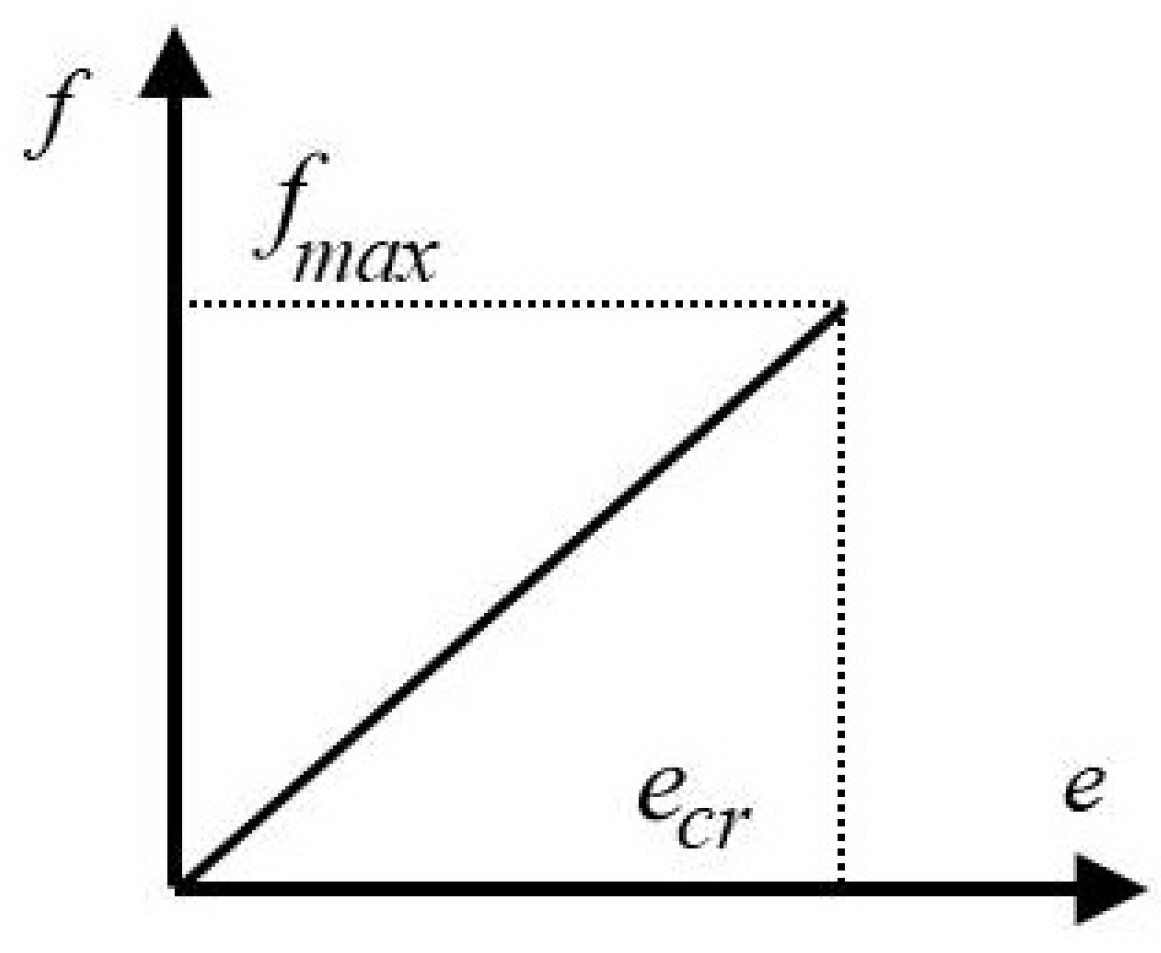
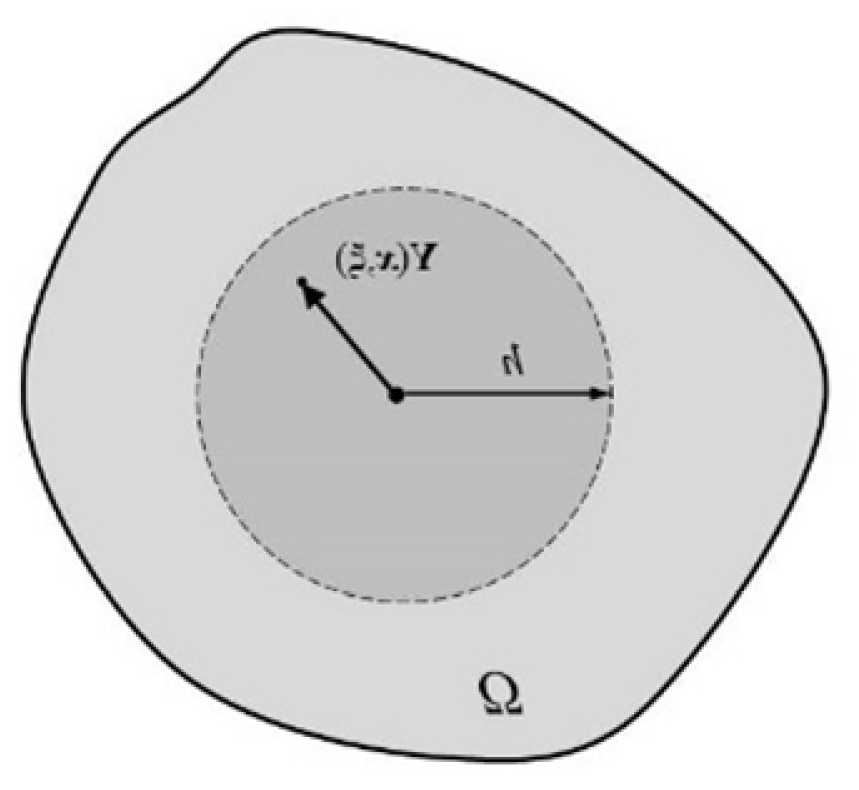
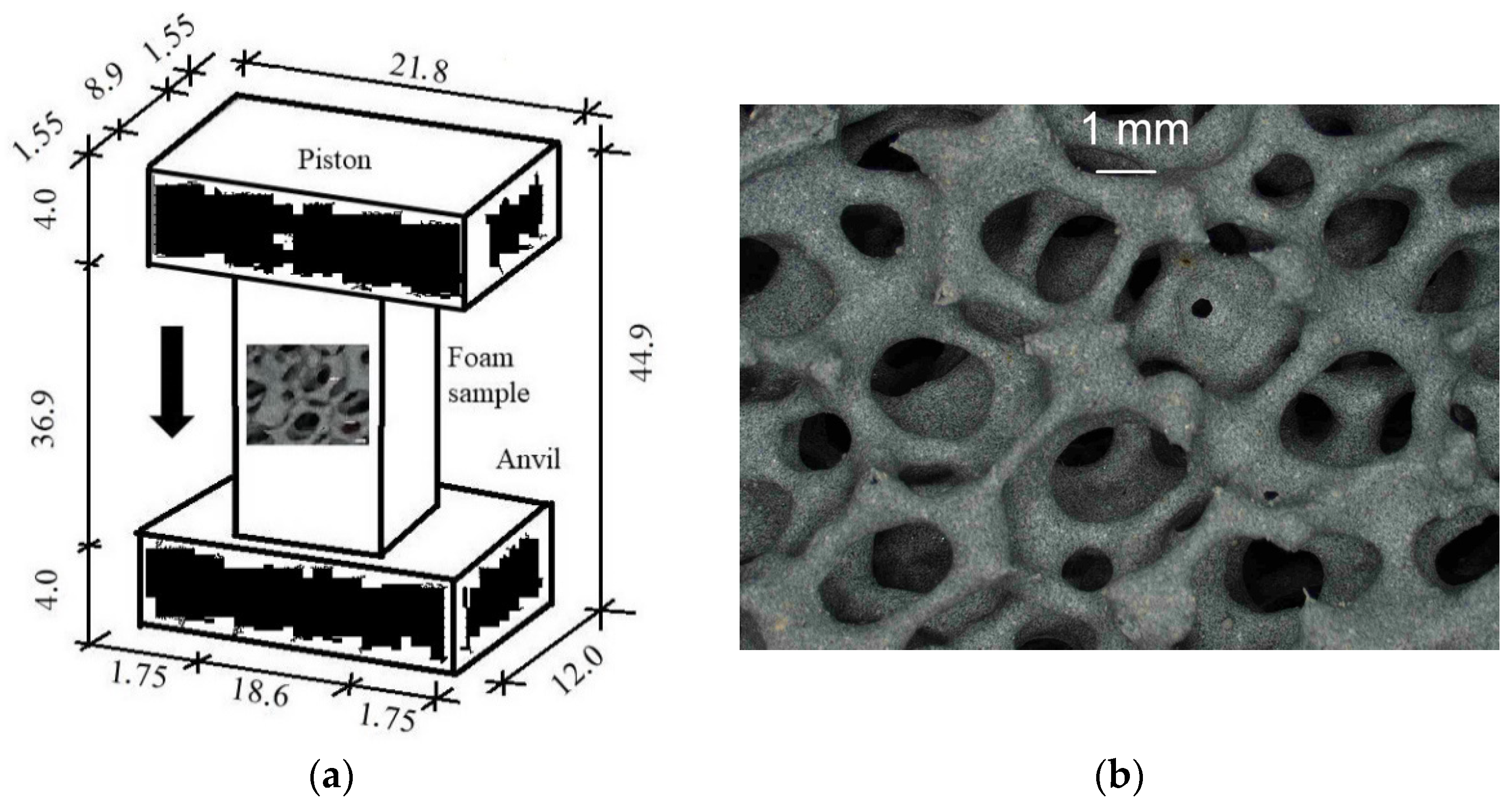
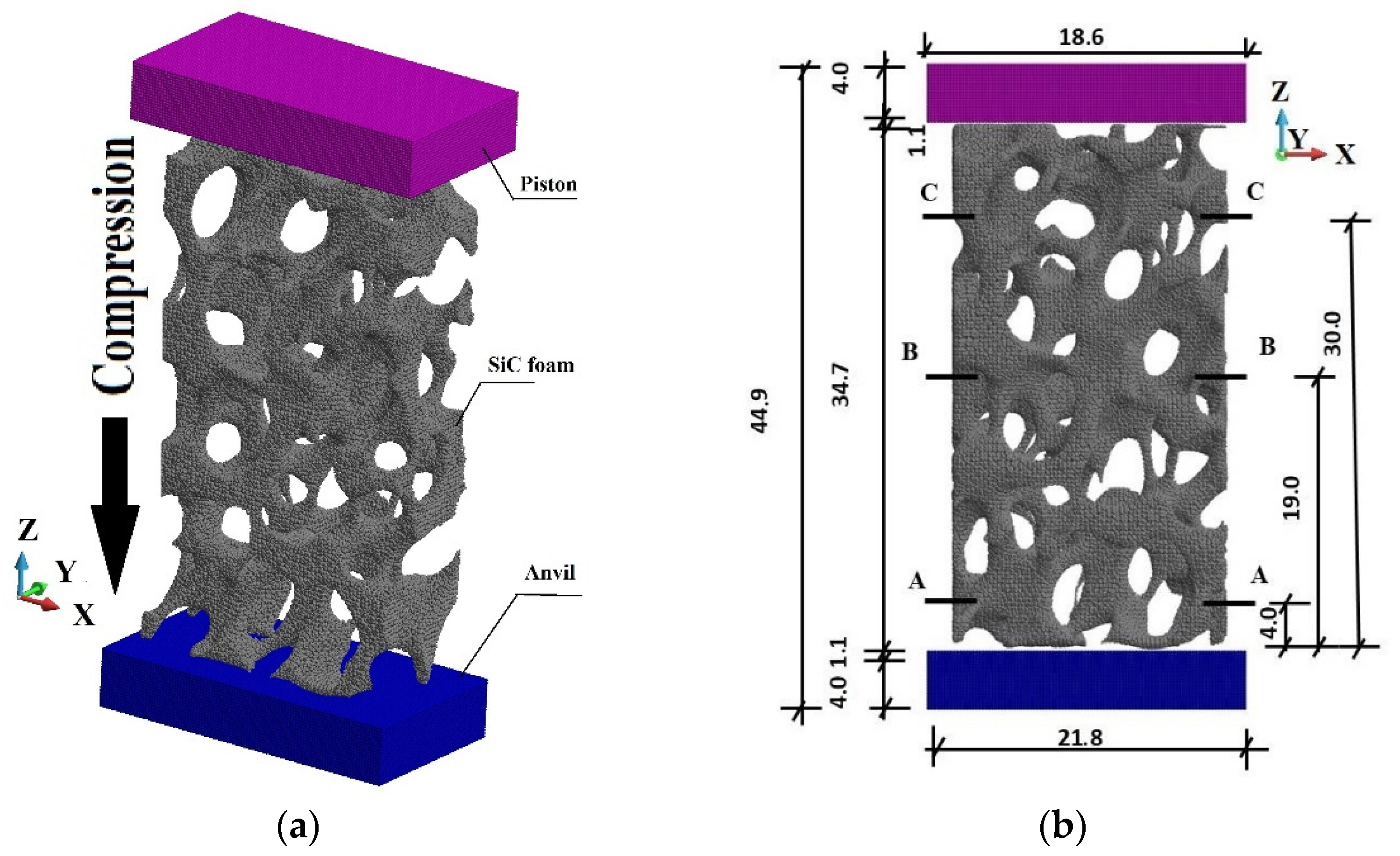
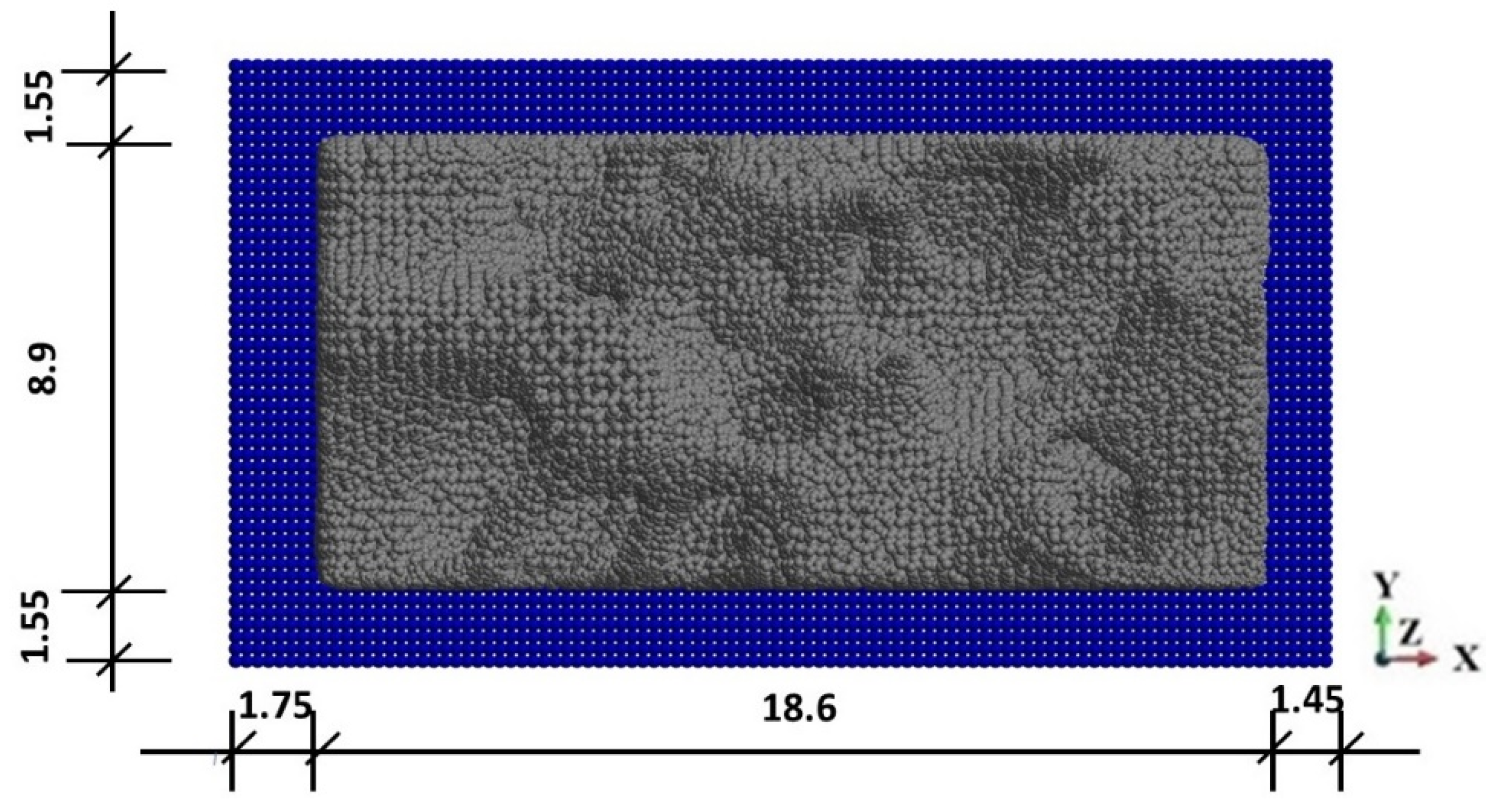
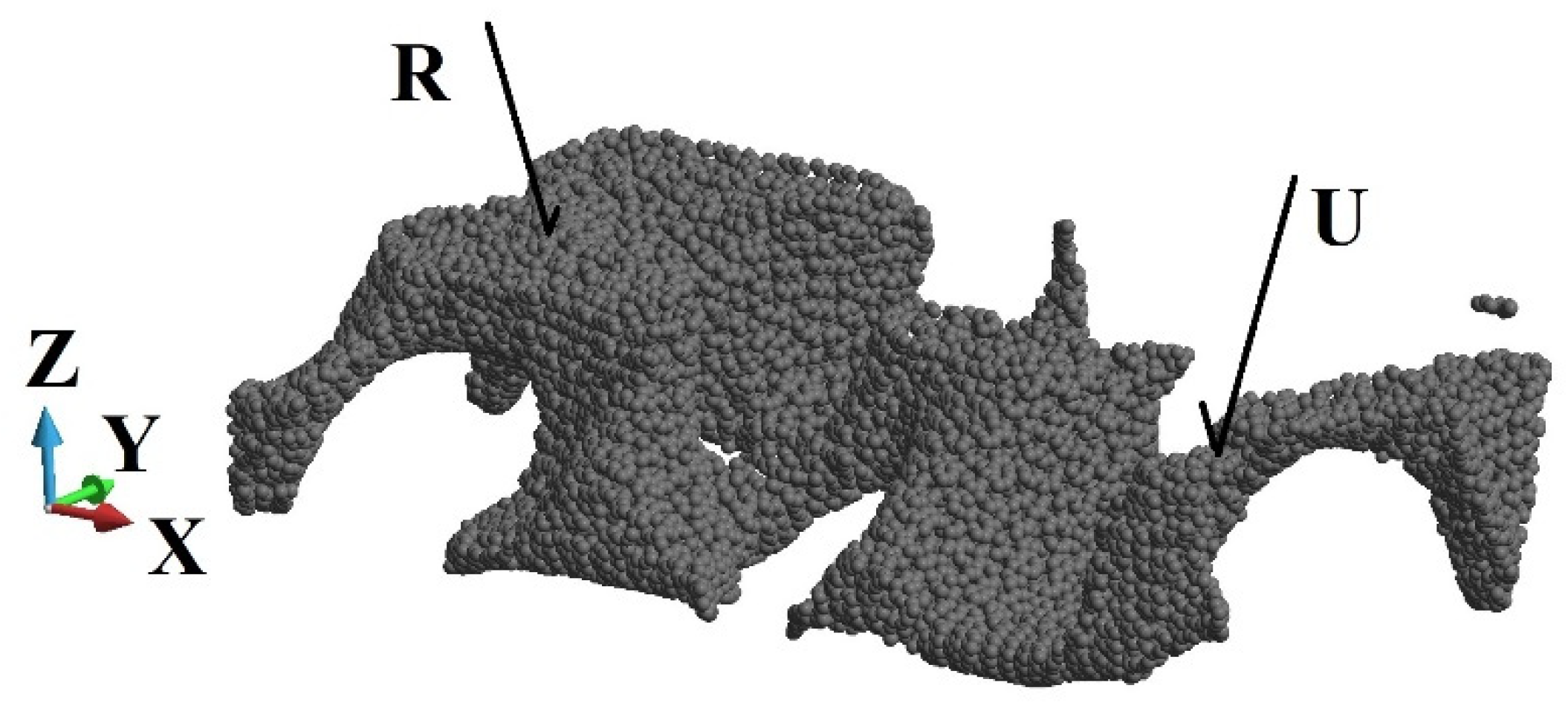

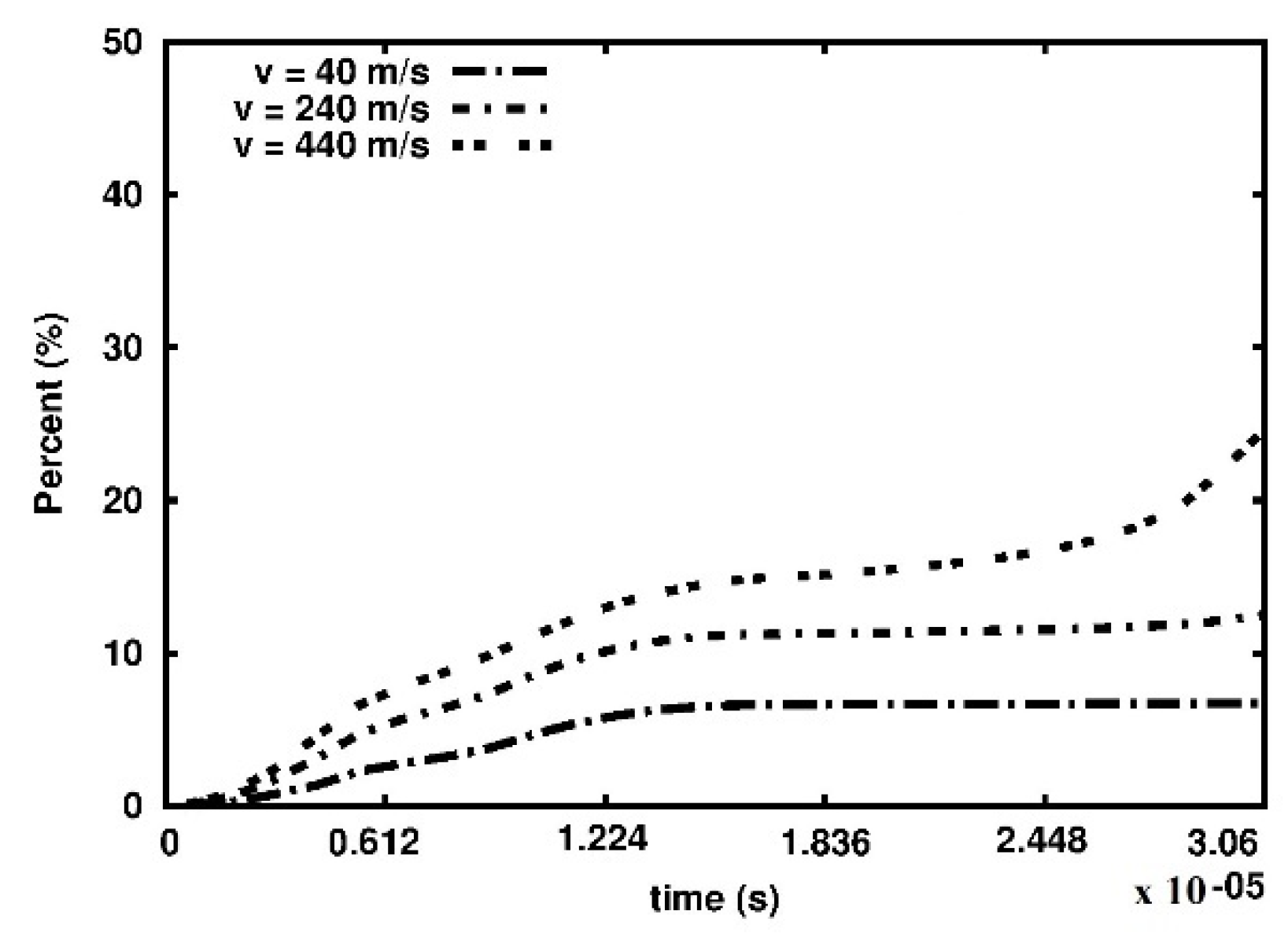
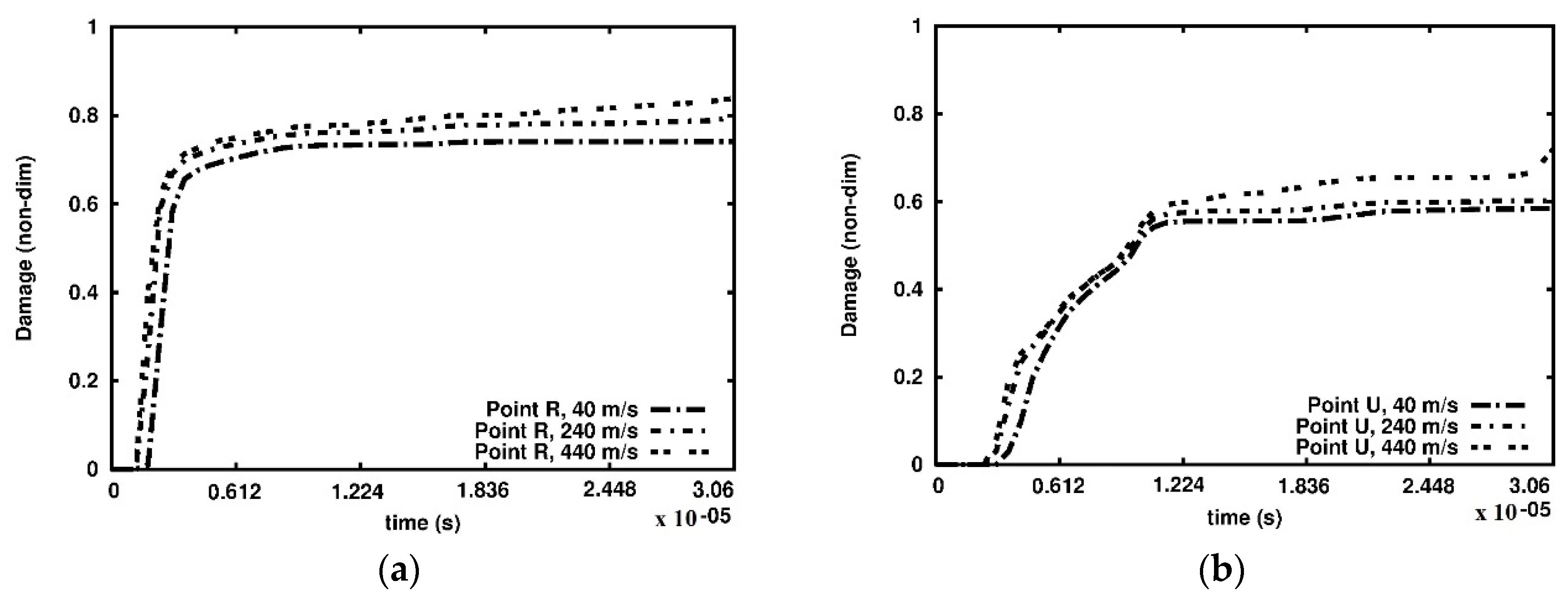
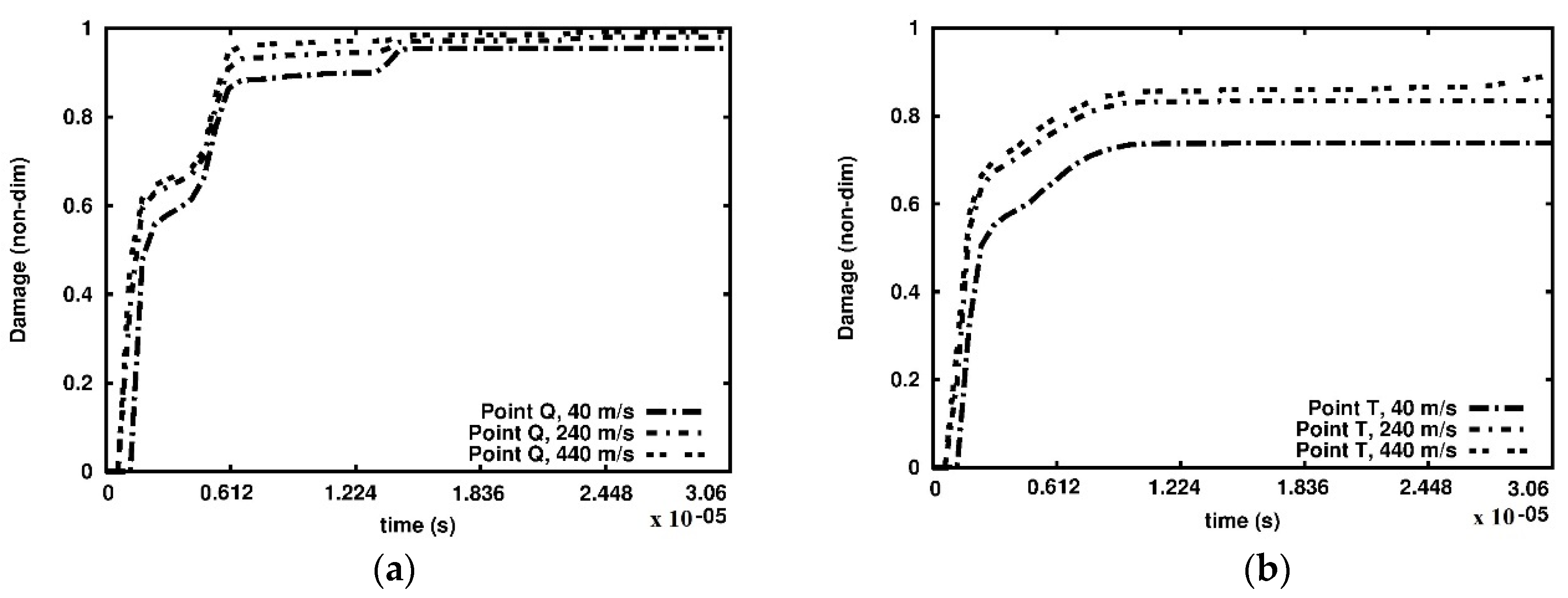
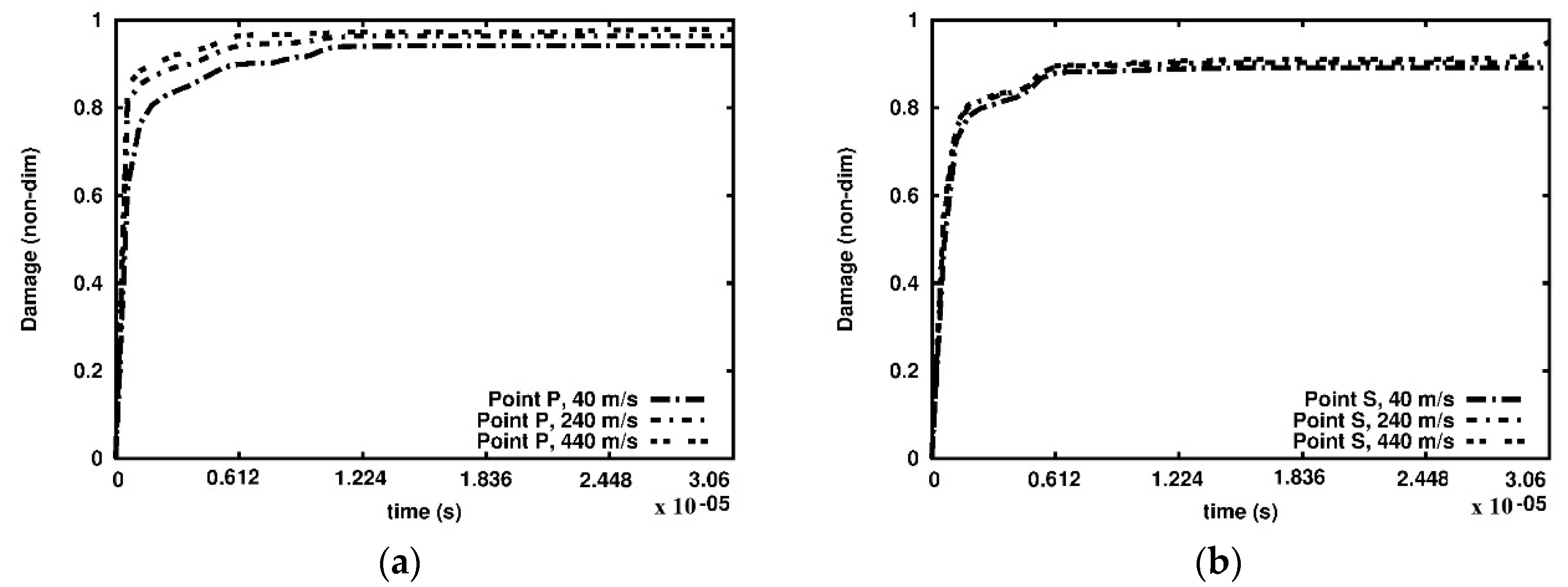
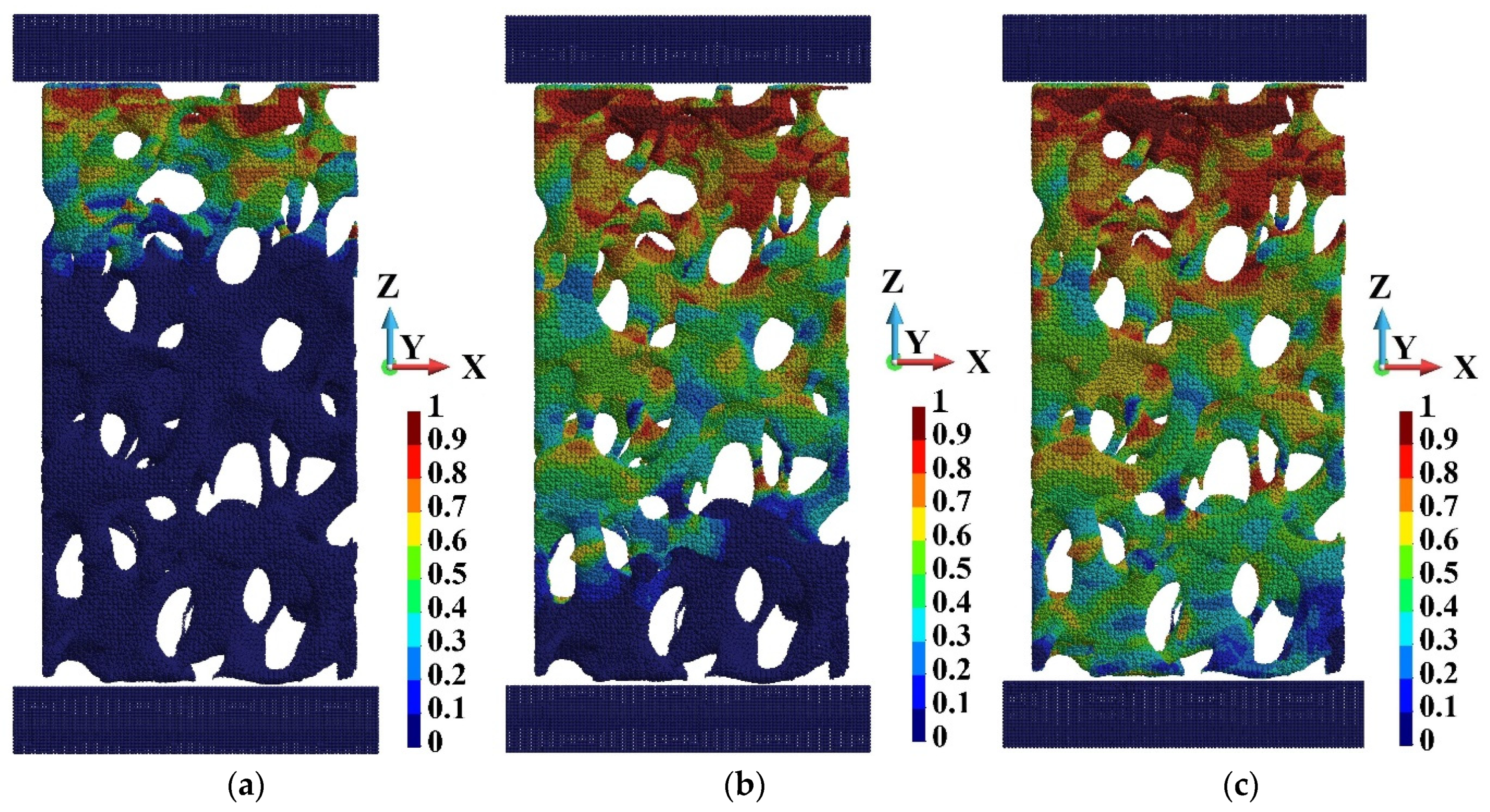
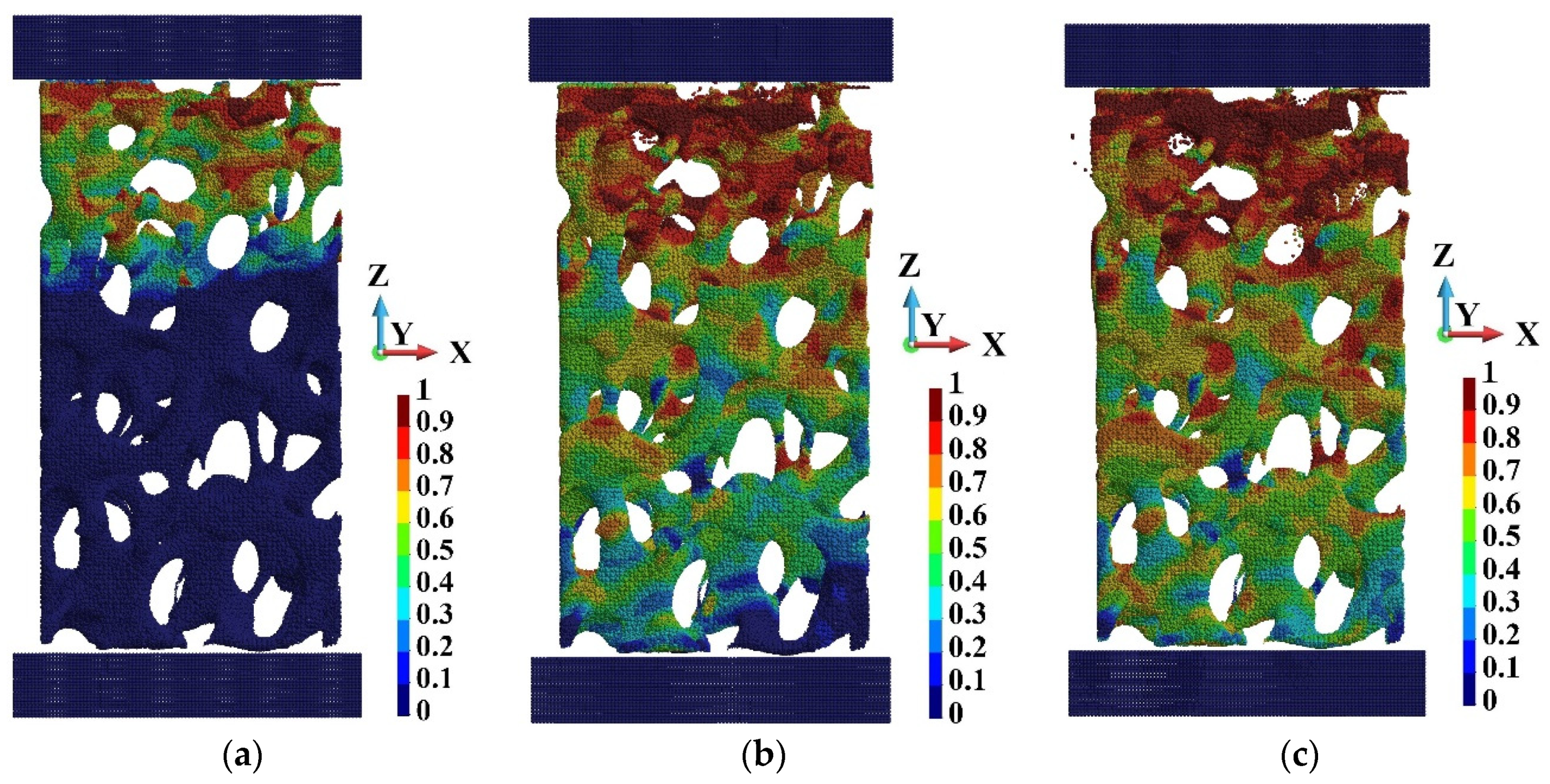
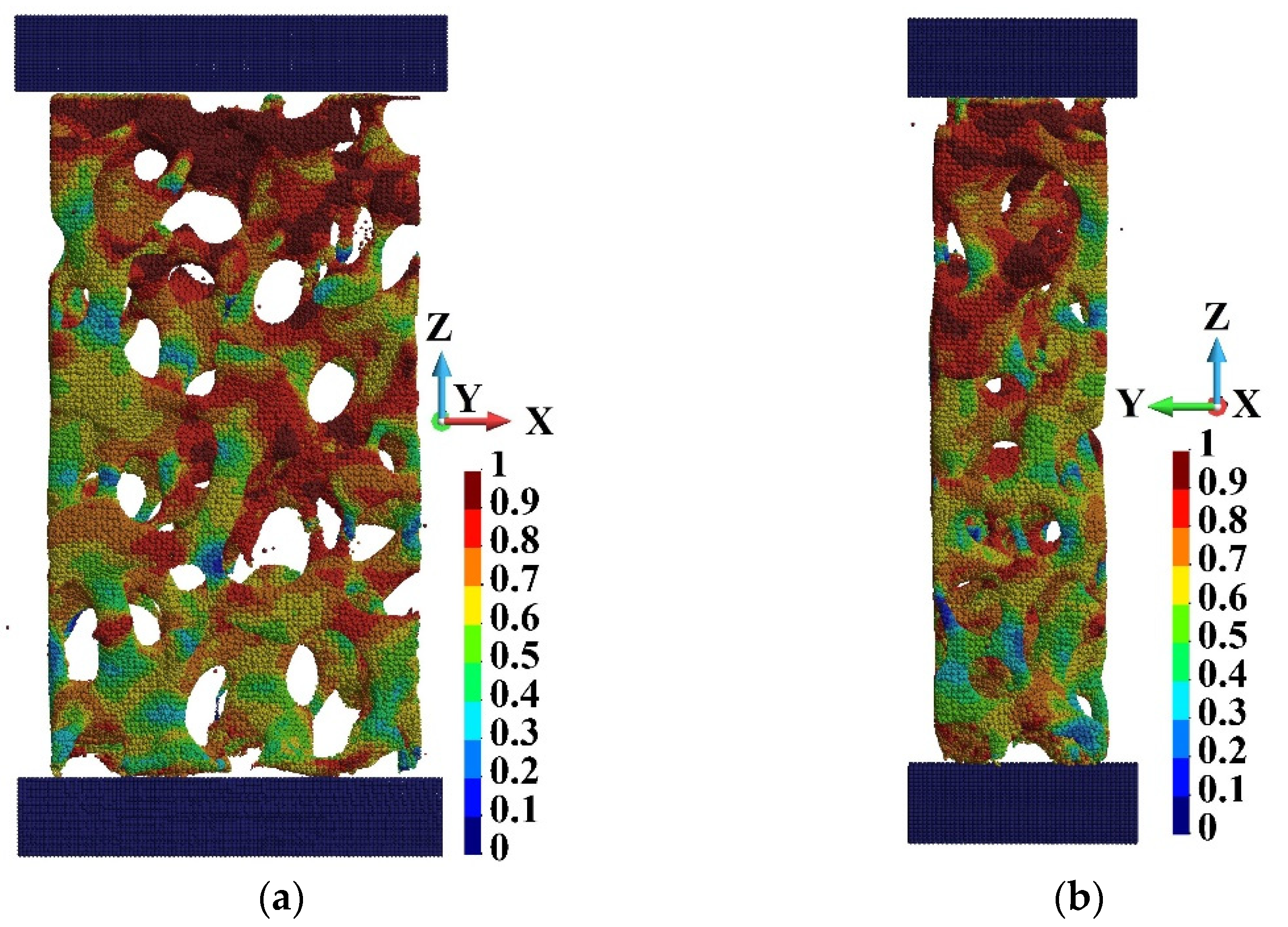
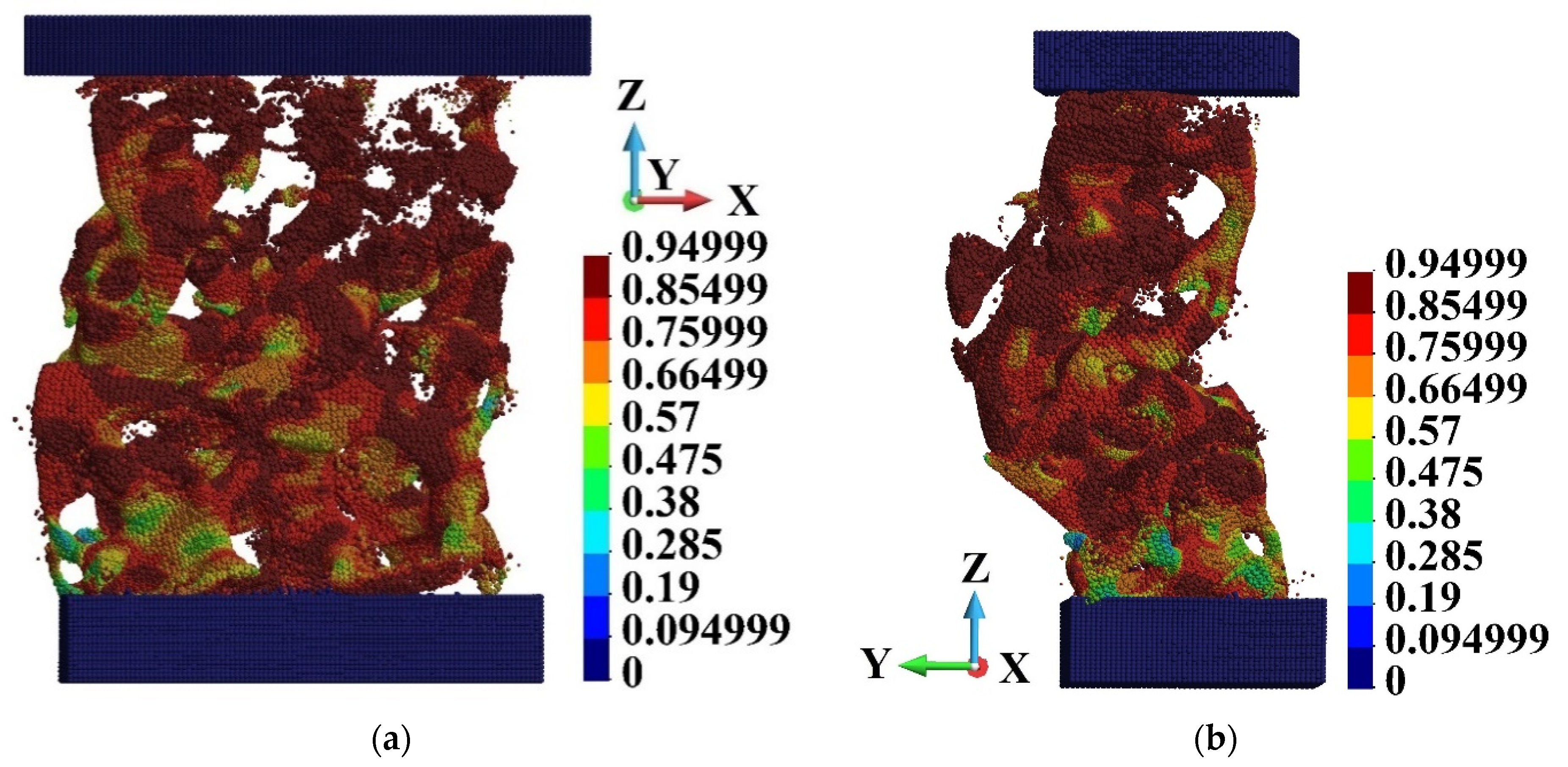
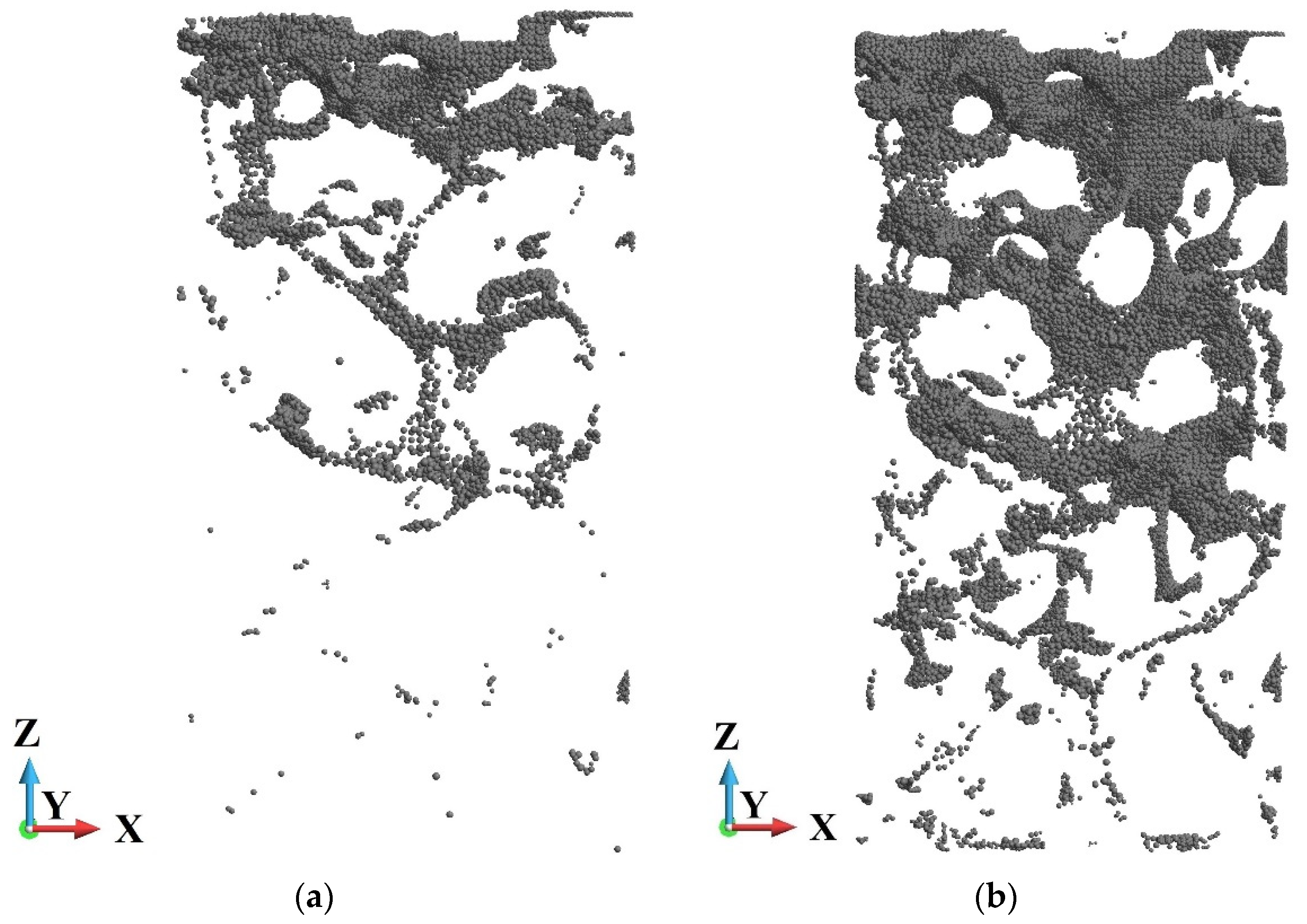
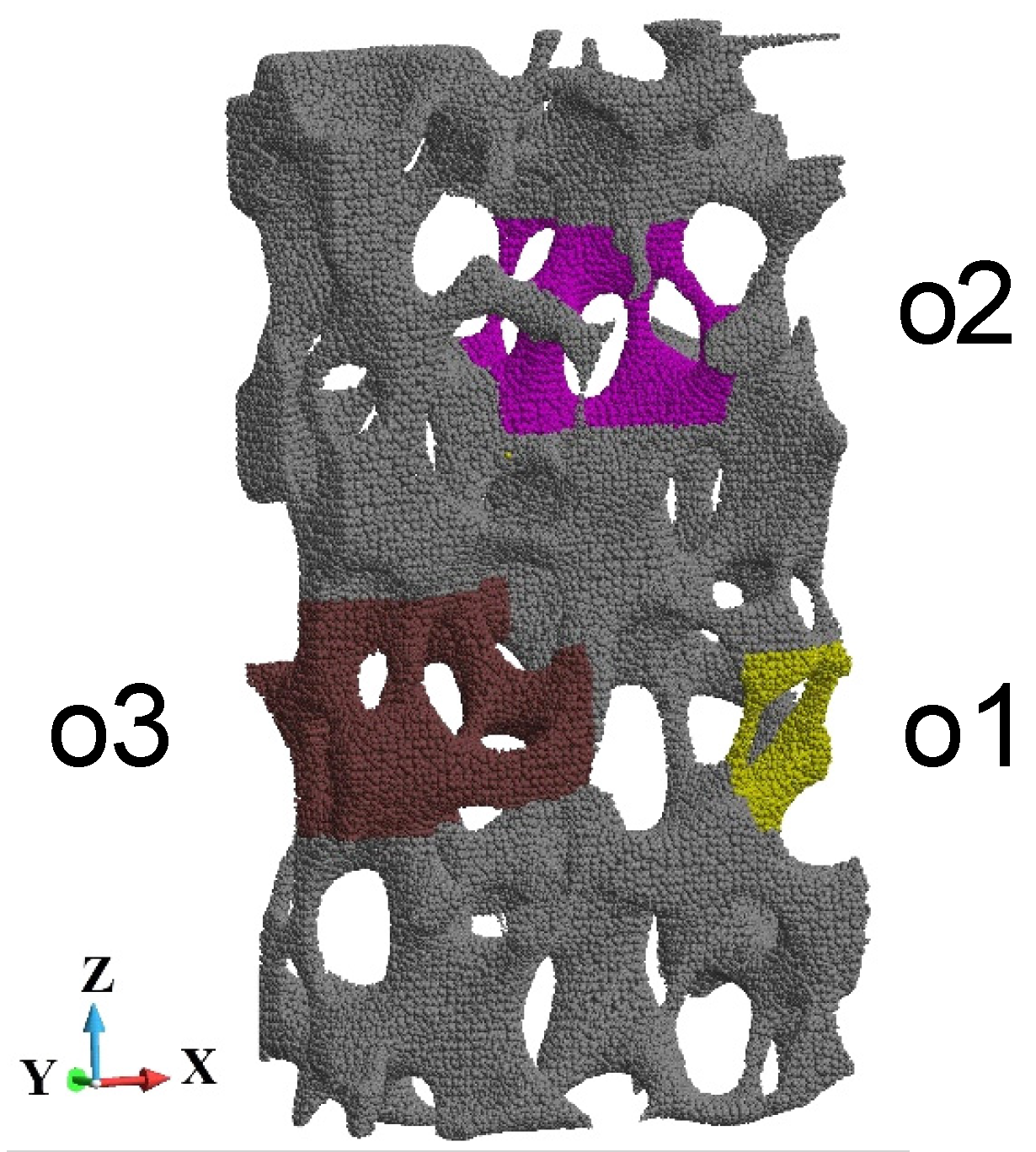




| Cross-Section | A-A | |||
|---|---|---|---|---|
| Point | R | U | ||
| Velocity | t (s) | d | t (s) | d |
| 40 m/s | 0.18 × 10−05 | 0.10 × 10−01 | 0.36 × 10−05 | 0.30 × 10−01 |
| 240 m/s | 0.18 × 10−05 | 0.26 | 0.30 × 10−05 | 0.32 × 10−01 |
| 440 m/s | 0.18 × 10−05 | 0.40 | 0.3 × 10−05 | 0.58 × 10−01 |
| Cross-Section | B-B | |||
|---|---|---|---|---|
| Point | Q | T | ||
| Velocity | t (s) | d | t (s) | d |
| 40 m/s | 0.18 × 10−05 | 0.48 | 0.12 × 10−05 | 0.16 x 10−02 |
| 240 m/s | 0.12 × 10−05 | 0.37 | 0.12 × 10−05 | 0.19 |
| 440 m/s | 0.12 × 10−05 | 0.47 | 0.12 × 10−05 | 0.27 |
| Cross-Section | C-C | |||
|---|---|---|---|---|
| Point | P | S | ||
| Velocity | t (s) | d | t (s) | d |
| 40 m/s | 0.6 × 10−06 | 0.62 | 0.6 × 10−06 | 0.48 |
| 240 m/s | 0.6 × 10−06 | 0.81 | 0.6 × 10−06 | 0.55 |
| 440 m/s | 0.6 × 10−06 | 0.85 | 0.6 × 10−06 | 0.57 |
Publisher’s Note: MDPI stays neutral with regard to jurisdictional claims in published maps and institutional affiliations. |
© 2022 by the authors. Licensee MDPI, Basel, Switzerland. This article is an open access article distributed under the terms and conditions of the Creative Commons Attribution (CC BY) license (https://creativecommons.org/licenses/by/4.0/).
Share and Cite
Postek, E.; Sadowski, T. Dynamic Compression of a SiC Foam. Materials 2022, 15, 8363. https://doi.org/10.3390/ma15238363
Postek E, Sadowski T. Dynamic Compression of a SiC Foam. Materials. 2022; 15(23):8363. https://doi.org/10.3390/ma15238363
Chicago/Turabian StylePostek, Eligiusz, and Tomasz Sadowski. 2022. "Dynamic Compression of a SiC Foam" Materials 15, no. 23: 8363. https://doi.org/10.3390/ma15238363
APA StylePostek, E., & Sadowski, T. (2022). Dynamic Compression of a SiC Foam. Materials, 15(23), 8363. https://doi.org/10.3390/ma15238363








